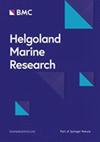Macrofaunal assemblages associated with two common seagrass‐dwelling demosponges (Amorphinopsis atlantica and Haliclona implexiformis) in a tropical estuarine system of the southern Gulf of Mexico
4区 地球科学
Q2 Agricultural and Biological Sciences
引用次数: 2
Abstract
Among the ecological roles that sponges play in marine ecosystems, one of the highlights is their ability to host a wide diversity and abundance of epibenthic organisms. However, of the different marine environments, this role has been less investigated in seagrass-dwelling sponges. In this study, the main objective was to determine whether the structure of the associated faunal assemblages in two common sympatric species of seagrass-dwelling sponges (Amorphinopsis atlantica and Haliclona implexiformis) vary depending on the volume and morphology of the host sponge as well as the environment to which both sponges are exposed. Even though the collection sites had the same habitat type (seagrass meadows composed by Thalassia testudinum and Halodule wrightii) and depth, there were substantial differences in faunal composition (ANOSIM test, R = 0.86) between both sponge species. The value of the data on species richness, diversity, and abundance of associated organisms was significantly higher in the individuals of A. atlantica than in those of H. implexiformis. These differences in the community structure of associated fauna could be influenced by the differential growth form of the hosts (e.g. growth form and oscula diameter) as well as their distinct environmental preferences (sites with different degrees of exposure to wind-generated waves and levels of human disturbance). This study contributes to the knowledge on the functional role that sponges play in seagrass meadows, one of the world’s most endangered ecosystems. Furthermore, it underlines the importance of examining both, the sponge morphology and the local environmental conditions, to explain spatial variations in the macrofaunal assemblages associated with sponges.墨西哥湾南部热带河口系统中与两种常见海草栖息海绵动物(atlantica和Haliclona implexiformis)相关的大型动物群落
在海绵在海洋生态系统中发挥的生态作用中,其中一个突出的特点是它们能够容纳丰富多样的底栖生物。然而,在不同的海洋环境中,这种作用在海草海绵中的研究较少。在这项研究中,主要目的是确定两种常见的同域海草海绵(大西洋魔芋和隐形海螺)的相关动物组合结构是否会因寄主海绵的体积和形态以及两种海绵所处的环境而变化。尽管两种海绵的生境类型和深度相同(海草草甸主要由海草和海草组成),但两种海绵的区系组成存在显著差异(ANOSIM检验,R = 0.86)。在物种丰富度、多样性和伴生生物丰度方面,大西洋拟南芥个体的数据价值显著高于隐形拟南芥个体。相关动物群落结构的这些差异可能受到寄主不同的生长形式(如生长形式和眼孔直径)以及它们不同的环境偏好(风浪暴露程度和人为干扰程度不同的地点)的影响。这项研究有助于了解海绵在世界上最濒危的生态系统之一海草草甸中的功能作用。此外,它强调了检查海绵形态和当地环境条件的重要性,以解释与海绵相关的大型动物组合的空间变化。
本文章由计算机程序翻译,如有差异,请以英文原文为准。
求助全文
约1分钟内获得全文
求助全文
来源期刊

Helgoland Marine Research
地学-海洋学
自引率
0.00%
发文量
0
审稿时长
6-12 weeks
期刊介绍:
Helgoland Marine Research is an open access, peer reviewed journal, publishing original research as well as reviews on all aspects of marine and brackish water ecosystems, with a focus on how organisms survive in, and interact with, their environment.
The aim of Helgoland Marine Research is to publish work with a regional focus, but with clear global implications, or vice versa; research with global emphasis and regional ramifications. We are particularly interested in contributions that further our general understanding of how marine ecosystems work, and that concentrate on species’ interactions.
 求助内容:
求助内容: 应助结果提醒方式:
应助结果提醒方式:


